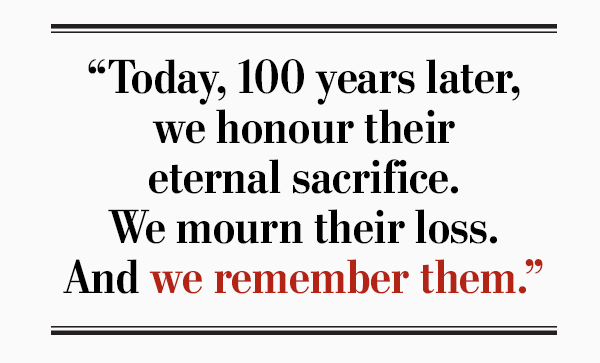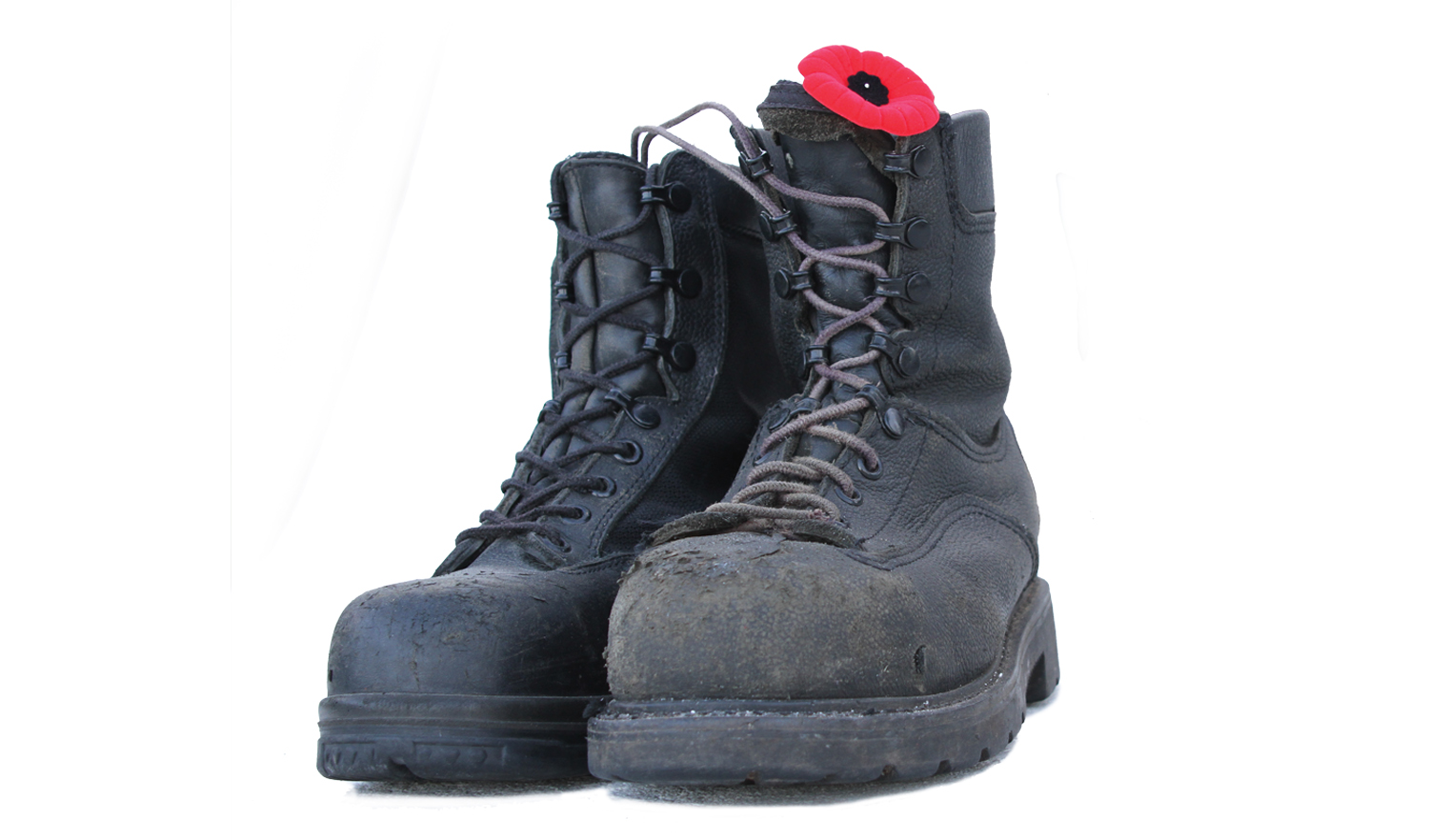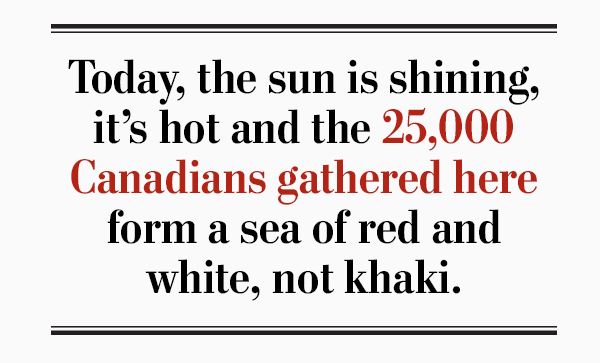

As we walk through the arched entrance to Maple Copse Cemetery, the tranquility immediately makes me pause. Located five kilometres southeast of Ypres, Belgium, the cemetery is one of many stops on a week-long journey marking the 100th anniversary of the Battle of Vimy Ridge. Aside from our small group of camera-toting journalists, the cemetery has only two visitors this day—a stark contrast with the busy days ahead at Vimy.
The site of an advanced dressing station in the spring and summer of 1916, Maple Copse contains 308 burials, half of which are Canadian. It is surrounded by maple trees, many of its headstones are decorated with Canadian flags, and the Canadian Hill 62 (Sanctuary Wood) Memorial can be seen in the distance. Memorials dedicated to Canadians are found throughout Flanders, the Dutch-speaking northern portion of Belgium. Canada is well represented here, and with good reason.
At the centre of Ypres, whose population of 35,000 remains immensely grateful to Canada for its service during the First World War, the spire and turrets of the Cloth Hall define the skyline for miles around. The medieval building was destroyed during the war, rebuilt prior to the Second World War (which it survived), and now houses the In Flanders Fields Museum, which presents visitors with the story of the First World War in West Flanders.

The Cloth Hall in Ypres was destroyed in the First World War, then rebuilt.
![]()
There are 231 steps to the top of its bell tower, which offers a panoramic view of what was, during the war, the Ypres Salient, an outward bulge in the military line. “You can see the salient there,” says guide Erwin Ureel, gesturing to the east. “It was quite small, and it moved back and forth in the four years of the war…but never more than six or seven kilometres.”
To the north is Passchendaele, a town that was at the heart of another monumental Great War battle. The view puts everything into perspective: four years of fighting, hundreds of thousands killed here, all for such a small tract of land.

A Last Post ceremony takes place daily at the Menin Gate Memorial to the Missing in Ypres.
![]()
A short walk from the Cloth Hall is the Menin Gate Memorial to the Missing, a triumphal arch that contains the names of 54,396 fallen Commonwealth soldiers who have no known grave. Row on row, names are inscribed on almost every surface. Each night, rain or shine, a Last Post ceremony takes place here, in salute to those whose names are on its walls.
Some of those names belong to those who died near here on April 22, 1915, when the Germans released more than 150 tonnes of chlorine gas downwind onto a section of the front line held by two French divisions, forcing them to flee or suffocate. This exposed Canada’s left flank and threatened other Allied positions in the salient. Canada’s 10th and 16th battalions were ordered to counter-attack a position called Kitcheners’ Wood, and with extraordinary courage, they pushed the Germans out, but at a cost of nearly 800 casualties. It was the first major offensive by Canadian troops in the war.

The St. Julien Memorial commemorates Canada’s participation in the Second Battle of Ypres in April 1915; it faces the direction from which the first large-scale German chlorine gas attack was launched.
![]()
Not far from Kitcheners’ Wood is the St. Julien Canadian Memorial, commonly known as the Brooding Soldier and one of the most impressive monuments in the Ypres Salient. This is where the Canadians themselves endured gas attacks on April 24, 1915. The soldier’s bowed head faces the fields across which the gas crept, and he is resting at arms reversed—leaning on a weapon pointing down—symbolizing respect for the fallen. Canada suffered more than 6,000 casualties in the Second Battle of Ypres, a third of its force, but held the ground until the British relief came. Canada’s reputation as a daring, fearless force was beginning to form.
North of Ypres is Essex Farm, where medical officer and then-Major John McCrae wrote “In Flanders Fields” in memory of a friend who was killed nearby on May 2, 1915. At the time, the farm was an advanced dressing station and McCrae was the second-in-command of his brigade. Bunkers at the site today are from later in the war and were restored by students, but they still give a sense of the conditions in which McCrae worked: dark, dank and confined—hardly ideal for practising medicine.

Symbols of remembrance are left among the bunkers at Essex Farm Cemetery, where John McCrae wrote “In Flanders Fields.”
![]()
Wherever we go in the salient, Canadian flags and poppies adorn headstones and memorials. Located on Canadalaan—Canada Lane—the Canadian Hill 62 (Sanctuary Wood) Memorial is no exception.
The battles for Mount Sorrel and hills 61 and 62 were fought over several months in the spring of 1916, a prelude to the Battle of the Somme. The objectives were fiercely contested many times, most notably in June. In the first days, the Germans launched vicious attacks, capturing their targets and nearly wiping out the Canadian Corps. But the Canadians would not give up, and after a four-day artillery bombardment, Canada recaptured the lost ground. The Hill 62 Memorial is an inscribed granite block at the centre of a stone tile plaza atop Mount Sorrel, commemorating 8,430 casualties. The view from here is striking, and embedded in the plaza around the block are nameplates and arrows pointing outward to places of significance in the war.

The sun is piercing through the fog as we leave Ypres early on April 9 en route to Vimy Ridge in France. By the time we arrive, there are already thousands of people at the site—students, teachers, cadets, veterans, families of veterans. When the attack started at dawn 100 years ago, sleet and snow chilled the battlefield and the Canadians had the wind at their backs. Today, the sun is shining, it’s hot and the 25,000 Canadians gathered here form a sea of red and white, not khaki.
“I’m here for two reasons,” says Tom Rolfe of Toronto. “My stepson is here with a school group from Toronto. And my grandfather—also Tom Rolfe—fought here and won the Military Medal.” Rolfe’s grandfather was gassed in another battle and sent home, but he survived and went on to serve in the Second World War and, remarkably, survived that too.
Betty Cunningham travelled here with a group from Georgetown, Ont., to remember Dr. Claude Williams. “Williams fought at Vimy and was awarded the Military Cross,” she says. “There are four generations of his family here. He was a very special man and we’re glad he came home.” Williams survived the war and practised medicine in Georgetown for 50 years.
Some 100,000 Canadian soldiers fought in the four-day battle, which marked the first time all four of our divisions were engaged side by side. Canada had 7,004 wounded and 3,598 killed in the battle.

One of 3,600 pairs of boots placed on the grounds of the Canadian National Vimy Memorial, representing each Canadian soldier who fell during the four-day battle.
![]()
Today the monument and its surrounding lawns have an extra, and poignant, appointment—the Boots of the Fallen pathway. Canadian and French youth have placed 3,600 pairs of military-issue boots worn by members of the Canadian Armed Forces. Each pair represents a soldier who died here.
A 21-gun salute signals the start of the formal ceremony, and as the dignitaries enter, a formation of five replica First World War biplanes flies past the monument’s twin pylons (which represent Canada and France). The ceremony is a tasteful combination of traditional memorial protocols and contemporary artistic performances.
“Victory was achieved through incredible struggle, determination and bravery,” says Governor General David Johnston in his address. “Today, 100 years later, we honour their eternal sacrifice. We mourn their loss. And we remember them.”
Much has been made of how the victory at Vimy was the catalyst for the birth of a nation, the moment when Canada forged a new identity as a strong, independent nation committed to peace. Prime Minister Justin Trudeau reflects on this in his address: “For their ultimate sacrifice…men of the British dominion fought for the first time as the people of one country. In that sense, Canada was born here.”

Honourary Lieutenant-Colonel Lionel Goffert of Toronto stands proud following the Vimy ceremony.
![]()
“They fought bravely and with great ingenuity,” says Charles, Prince of Wales. “They succeeded in seizing the vital high ground of Vimy, a task in which many others before them had failed. However, victory came at an unbearably heavy cost.”
The ceremony is interspersed with actors portraying the lives of soldiers on the front lines and of wives, mothers and fathers on the home front and performances of songs, including “L’hymne à la Beauté du Monde,” “Dante’s Prayer,” “Salluit,” “The Lament,” “Dedicated to You,” “In Flanders Field” and “Crier tout bas.”
Three Canadian veterans, representing Canada’s English, French and aboriginal peoples, read the Act of Remembrance before Sergeant Guillaume Damour’s “Last Post” bugle call ushers in one minute of silence.

A boy dressed as a soldier sits at the base of the Vimy memorial.
![]()
The governor general, Prince Charles, the prime minister and President François Hollande of France place wreaths at the monument’s base and the national anthems—God Save the Queen, O Canada and La Marseillaise—reverberate across the ridge, replaced by the roar from French Armed Forces fighter jets flying past.
“I had to come,” says Harry Watts of Kitchener, Ont. He is a Second World War veteran and Royal Canadian Legion member. “I’ve never been here. I’ve been to every other place in Europe: Italy, Holland, but never here. I decided it was time.

“I have tears in my eyes looking at all these young people. I’m very emotional about it because they want to come and check it out as part of their history. It’s wonderful.”
With the ceremony completed, people from the audience swarm the memorial for an up-close appreciation of its sheer enormity and the battle it represents. Again, as at the Menin Gate, there are row on row of names inscribed on the limestone walls, this time for the 11,285 Canadian soldiers missing and presumed dead in France.

The moon rises over the Vimy memorial at the end of a poignant day of commemoration.
![]()
On the flight back to Canada, I reflect on my remarkable time in Belgium and France, where I stood on many of the same fields on which Canada’s soldiers spent four years fighting—and dying.
I think of Maple Copse and how the original cemetery was destroyed by more battles after the fight for Mount Sorrel in 1916. Only 78 of the graves known to exist at the cemetery have been located, and only 26 have been identified. On the headstones of 230 graves that were destroyed beyond recognition are the words “Known To Be Buried In This Cemetery.”
Among them is the grave of 15-year-old Private Frederick Freeman Laing of Halifax. Too young to join the war effort, Laing was only 14 when he stowed away on SS Caledonia in August 1915. He surrendered himself and was taken on strength by the Royal Canadian Regiment, trained and sent to the front line. He was killed in action on May 11, 1916, one of the youngest Canadians killed. To me, Laing represents every Canadian whose final resting place is in the Ypres Salient or France: youth, determination, courage, sacrifice. Every Canadian should have such an opportunity to visit this hallowed ground.
![]()
Top Photo: Southeast of Ypres, Belgium, is Maple Copse Cemetery, the final resting place of 154 Canadian soldiers from the First World War.
Advertisement






















